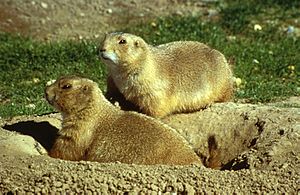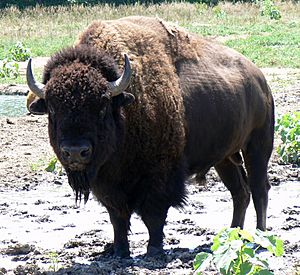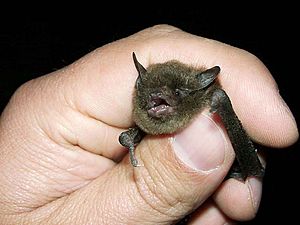Great Plains ecoregion facts for kids
The ecology of the Great Plains is very diverse. This is because the area is huge! Differences in rainfall, elevation, and how far north or south it is create many different homes for plants and animals. These include short grass, mixed grass, and tall-grass prairies. There are also river areas.
The Great Plains stretch from Mexico in the south, through the central United States, and up to central Canada. Many smaller areas exist within this huge region.
Many animals live here, like the American bison, pronghorn, mule deer, and white-tailed deer. Birds like ducks, hawks, and sparrows are also common. Plus, there are many tiny creatures without backbones.
When people settled this area, often called "America's breadbasket," it caused some harm to nature. Farming led to almost all American bison disappearing in the late 1800s. Also, less than 1% of the tallgrass prairie is left. Now, the plains are mostly farms and big ranches. But, some groups are working to bring back these important natural areas. For example, the American Prairie Reserve in Montana is helping the threatened ecosystem grow again.
Contents
Climate of the Great Plains
The climate here is special because of many different wind patterns. Air moves from east to west and north to south. Since the Great Plains are in the middle of the United States and Canada, many different air masses pass through. This causes the weather to change a lot. The western Great Plains are quite dry, while the eastern part is much wetter.
The Great Plains have all four seasons: summer, autumn, winter, and spring. But each season can bring extreme weather. For example, in the southern parts, it can be over 90°F (32°C) for 70 to 100 days a year. In the northern parts, it's only that hot for 10 to 20 days. These changing air masses cause the varied climate.
Different air masses bring different temperatures and moisture.
- Cold, dry air comes from central Canada.
- Hot, dry air comes from the Gulf of Mexico and the Caribbean.
- Warm, moist air comes from the southwest United States and Northern Mexico. Sometimes this air can be dry.
- Cool, moist air comes from the Pacific Ocean. It moves east over the mountains and becomes warm and dry.
These air masses make the seasons very extreme. Winters can be harsh and change a lot. Mid-summer brings warm, moist, or dry air, depending on the area.
Precipitation (rain and snow) also changes across the region. Areas near the Gulf of Mexico get over 40 inches (100 cm) of rain each year. Western areas, like Montana, get less than 14 inches (35 cm). In winter, the southern region gets less than an inch of snow. But northern regions get over 40 inches (100 cm). Spring brings a lot of rain. Cold, dry air mixes with moist air from the Gulf. This creates strong thunderstorms with heavy rain, high winds, hail, and tornadoes. In the Northern Plains, snow covers the ground for most of winter. This means steady precipitation in winter. But in hot summer, there's more chance of drought with only scattered heavy rains.
Climate change and its effects
Because the climate changes so much across the Great Plains, climate change won't affect all areas the same way. For rain, it means dry areas in the south will get even drier. Wetter areas in the north will get even wetter. This will make droughts worse in some places. It could also cause more floods in the wetter north. How much rain changes depends on future pollution levels. More pollution means bigger changes.
Temperatures are also expected to rise a lot. Average winter temperatures have already gone up by 7°F (4°C) in the last 30 years. This means warmer winters and springs. Summers in the south-central plains will also be hotter.
These changes could affect the plants and animals in many ways. Extreme droughts could kill plants. This might hurt farming in some areas and increase soil erosion. Losing soil and moisture could make it hard for new ecosystems to grow. It could also let tough invasive plants take over. Droughts could also dry up "prairie potholes." These are small wetlands important for many species, especially birds that migrate.
Temperature changes might make some species move to new areas. This could cause new competition between species that never lived together before. It might also reduce or wipe out species that can't move or adapt. Warmer springs could also change when plants bloom or animals reproduce. This could make them out of sync with their ecosystem. Over time, this could lead to a loss of different kinds of plants and animals. It could also mean less overall life in the region.
Land and soil of the Great Plains
Long ago, huge glaciers formed in Canada. They moved south over the central, flat plains in the United States. These glaciers and the dirt they left behind greatly changed the land. The biggest changes happened between the Missouri and Ohio Rivers. One key natural factor affecting the Great Plains is the weather combined with the flat land. This flat land is a result of the glaciers smoothing everything out.
Flat land means there is little difference in height across the region. These flat landscapes, like the grasslands of the Great Plains, affect how rain is spread out. Rainfall in this area increases from west to east. This leads to different types of prairie grasslands.
The shape of the land in the Great Plains also affects the soil. More soil organic matter (decayed plants and animals) is found in lower areas like grasslands. Higher spots, like buttes and mesas in the northwest, have less. In dry short-grass regions, like the High Plains, the soil usually doesn't hold much moisture. Plants here depend on any water already in the soil during dry times. The soil is usually well-drained and made of loam and clay.
Special plants, like various forbs and shrubs, grow in this soil. They have amazing adaptations. For example, their root systems are huge and complex. They can make up about 90% of the plant's weight! This helps the plants stay firmly in the ground. Their roots can also reach moisture deep in the soil. In tallgrass prairies, water is more common. The soil holds more moisture, so plants have smaller root systems.
Water in the Great Plains
The Great Plains has many water bodies that are important to its unique water system. There are thirteen rivers in the Great Plains region. Most rivers that start in the Rocky Mountains in the west provide water for farms. These rivers get a lot of water from melted snow in the mountains. This feeds the rivers during the growing season.
Another water source is wetlands. The most wetlands are in the northern part of the plains, where glaciers once were. Up to half of some northern Great Plains areas are wetlands. These wetlands, and those in the Nebraska Sandhills, are major breeding and resting spots for birds that migrate. Playas, which are temporary lakes in the southwestern United States, also provide homes for migrating birds in winter.
The Ogallala Aquifer is a very important source of fresh water for the entire Great Plains. It provides drinking water for 80% of the people. It also waters 13 million acres of farmland. Rain, seasonal lakes, and ancient water reserves fill the aquifer. It lies under 174,000 square miles of the central and southern regions. It holds a huge amount of water. About 200,000 wells use this water for irrigation. About 95% of the water pumped from the aquifer is used for farming.
The playa lakes are the main way the aquifer gets refilled. On average, it refills by about 0.5 inches per year. As more people live here and farming grows, the demand for water has increased. This has caused the average water level in the aquifer to drop by 13 feet since 1950.
Environmental challenges
The biggest environmental challenges for the Great Plains are water running out, land damage, and rising temperatures. Winters have become much warmer in the Plains, whether in the North near North Dakota or in the South throughout Texas. However, the winters of 2014, 2015, and 2016 were exceptions. Even though winters are getting warmer, summers are expected to get even hotter.
This big increase in temperature is predicted to cause more frequent extreme events. These include heat waves, droughts, and very heavy rainfall. This temperature rise will cause water sources, which are already shrinking, to run out even faster. Less water in the Great Plains will harm everyone.
Most of the water used in the Great Plains comes from the High Plains aquifer (also called the Ogallala aquifer). This aquifer stretches from South Dakota to Texas. Saving water in the Great Plains is one of the most important things to keep the region healthy. It's also very important for farmers to use sustainable practices. There are many ways to farm sustainably, but it's hard to choose the best one. Farmers are not always likely to change their ways. This makes the future for the Great Plains uncertain.
New methods and ways to measure things are needed. The biggest challenge in making such a large area sustainable is getting many farmers to use practices that don't harm the land. This is hard because there are so many different farming methods. To protect the prairie, we need:
- New technology to help decide what prairie areas to save.
- Nature-based plans to fix the big losses of native grasslands.
- New ways of thinking about how to manage the land.
- A new natural resource agency.
Habitats of the Great Plains
The Great Plains has many different types of habitats because it is so large. Differences in how far north or south an area is, its elevation, and how close it is to water all shape these grassland ecosystems.
Tallgrass prairies

Tallgrass prairies are found in the southern and eastern parts of the Great Plains. They once covered 170 million acres in North America. Now, less than 4% remains. Most of it is in the Kansas Flint Hills. This area is lower and wetter than the High Plains. It is also warmer than many other regions. Some places here get more than 40 inches (100 cm) of rain each year. Grasses here include bluestems and many other species. Historically, many areas of the Midwest that are now forests were once tallgrass prairie. Fire is very important for keeping the prairie healthy. Without it, many areas can turn into forests.
Short-grass prairies
Short-grass prairies are found in the high plains of Colorado, Kansas, Montana, Nebraska, New Mexico, North Dakota, Oklahoma, South Dakota, Texas, and Wyoming. About 70% of the original short-grass prairie still exists today. This makes it one of the least broken-up prairie ecosystems.
Plants of the Great Plains
Grasslands grow where there isn't enough rain for trees to survive. So, only grasses and a few shrubs can live there. There are three kinds of grasslands on the Great Plains: short-grass prairie, mixed grass, and tallgrass prairie. In all of them, grass species are the most important. They provide food and shelter. They also act as homes for young insects. Historically, they were the main food for buffalo. These grasses are vital for the ecosystem. They protect the soil from the strong winds that blow across the prairie. All these grasses can handle dry conditions. They have strong, short roots that hold the soil in place.
In short-grass prairie, there are two main plants. Buffalo grass (Bouteloua dactyloides) is a strong, tough grass that grazing animals love. The second is blue grama (Bouteloua gracilis). This grass is essential for keeping the soil from washing away.
In tallgrass prairie, there are four main species. These are big bluestem grass (Andropogen gerardii), Indian grass (Sorghastrum nutans), switch grass (Panicum virgatum), and little bluestem (Schizachyrium scoparium). Big bluestem grass grows 4–8 feet (1.2–2.4 meters) tall. It was the favorite food of the buffalo.
Animals of the Great Plains
A "keystone species" is an animal or plant that is super important to its community. It has a much bigger impact than its numbers might suggest. Keystone species on the Great Plains include the bison and the prairie dog. Many other animals live on the grasslands, like deer, rabbits, mice, and many types of birds.
Prairie dogs: Ecosystem engineers
In the Great Plains, the prairie dog is a keystone species. Studies show that prairie dogs greatly affect their surroundings. They change the plants by grazing. This then affects the homes and food for other animals. Prairie dogs create a mix of different plant types across the Great Plains. This is because they eat the long grasses. This mix supports many small mammals.
Besides changing plants, prairie dogs also create homes for many other creatures. They dig huge tunnel systems. Other small mammals, like the desert cottontail, striped skunk, and deer mouse, use these tunnels for shelter. A key sign of a keystone species is its ability to create and change habitats for other organisms. Prairie dogs clearly do this. So, the prairie dog is an iconic animal in North America. Its strong link to the ecology and structure of the Great Plains makes it a defining keystone species of the region.
There are several types of prairie dogs in this area. These include black-tailed, white-tailed, and Gunnison's. The black-tailed prairie dog is the most common and widespread.
Bison: The grassland grazers
The American bison (Bison bison) once roamed the Great Plains grasslands in huge herds. Their total population was once in the tens of millions. They lived across most of North America. The bison was like a "lawnmower" for the grasslands. But their shrinking numbers have greatly reduced their impact on nature.
The bison had a huge influence as a grazer. They turned a lot of plant material into animal biomass. They were also a key part of recycling nutrients. These roles are now mostly lost. Their grazing habits were vital for creating much of the biodiversity we see today. This includes helping the prairie dog. Along with fire, bison helped remove extra plant material that built up in the grasslands. When too much dead plant material piles up, seeds can't grow well. This stops new plant types from appearing. Removing this extra material helped promote and keep many different plant species on the plains.
While the American bison once played a keystone role in both creating and maintaining the Great Plains' biodiversity, their much smaller population today has little effect on the region's ecology.
Endangered species of the Great Plains
Indiana bat: A night hunter
The Indiana bat is an important predator in the Great Plains. This bat helps keep nature balanced by eating moths, mosquitoes, and flies at night. During winter, these bats sleep in abandoned caves and mines to hibernate. In warmer seasons, they sleep under tree bark. The Indiana bat is endangered mainly because people disturb them in their caves.
However, help is on the way to protect this species. Besides being careful around these bats, gates are being put up. These gates stop visitors from entering caves and mines during the hibernation months. Studies are also happening to find out other reasons why the Indiana bat's population is shrinking.
Small White Lady's Slipper: A rare orchid
Another rare species in the Great Plains is the Small White Lady's Slipper. There are only about 100 of these beautiful orchids left. Invasive species (plants that take over) and land developers have both helped to reduce this population. People picking these flowers has also caused harm.
The only working way to save the Small White Lady's Slippers involves controlled fires. These fires remove surrounding invasive plants. This gives the Small White Lady's Slippers enough space and nutrients to grow back. This plant needs to grow next to a fungus to survive. They have a special partnership.





